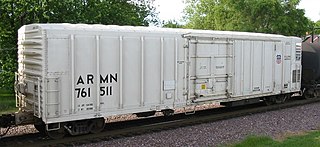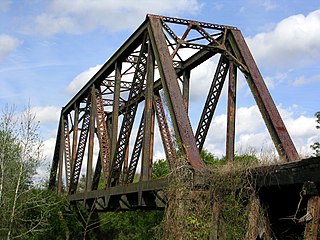
CSX Transportation, known colloquially as simply CSX, is a Class I freight railroad company operating in the Eastern United States and the Canadian provinces of Ontario and Quebec. Operating about 21,000 route miles (34,000 km) of track, it is the leading subsidiary of CSX Corporation, a Fortune 500 company headquartered in Jacksonville, Florida.

The Seaboard Coast Line Railroad was a Class I railroad company operating in the Southeastern United States beginning in 1967. Its passenger operations were taken over by Amtrak in 1971. Eventually, the railroad was merged with its affiliate lines to create the Seaboard System in 1983.

NJ Transit Rail Operations is the rail division of NJ Transit. It operates commuter rail service in New Jersey, with most service centered on transportation to and from New York City, Hoboken, and Newark. NJ Transit also operates rail service in Orange and Rockland counties in New York under contract to Metro-North Railroad. The commuter rail lines saw 45,838,200 riders in 2022, making it the third-busiest commuter railroad in North America and the longest commuter rail system in North America by route length.

A refrigerator car is a refrigerated boxcar (U.S.), a piece of railroad rolling stock designed to carry perishable freight at specific temperatures. Refrigerator cars differ from simple insulated boxcars and ventilated boxcars, neither of which are fitted with cooling apparatus. Reefers can be ice-cooled, come equipped with any one of a variety of mechanical refrigeration systems, or utilize carbon dioxide as a cooling agent. Milk cars may or may not include a cooling system, but are equipped with high-speed trucks and other modifications that allow them to travel with passenger trains.

CSX Corporation is an American holding company focused on rail transportation and real estate in North America, among other industries. The company was established in 1980 as part of the Chessie System and Seaboard Coast Line Industries merger. The various railroads of the former Chessie System and Seaboard Coast Line Industries that are now owned by CSX Corporation were eventually merged into a single line in 1986 and it became known as CSX Transportation. CSX Corporation currently has a number of subsidiaries beyond CSX Transportation. Previously based in Richmond, Virginia after the merger, the corporation moved its headquarters to Jacksonville, Florida, in 2003. CSX is a Fortune 500 company.
Anthony Talamo Rossi was an Italian-born American who founded Tropicana Products, a producer of orange juice, in 1947 in Bradenton, Florida. It grew from 50 employees to over 8,000 in 2004, expanding into multiple product lines and becoming one of the world's largest producers and marketers of citrus juice.

Tropicana Brands is an American fruit-based beverage company. It was founded in 1947 by Anthony T. Rossi in Bradenton, Florida. Between 1998 and 2021 it was a subsidiary of PepsiCo. In August 2021, 61% of Tropicana was sold along with the rest of PepsiCo's juice brand portfolio for $3.3 billion to PAI Partners. PepsiCo retained the remaining 39% of the companies ownership.

The EMD GP16 are a series of rebuilt diesel-electric locomotives, a result of a remanufacturing program initiated by the Seaboard Coast Line Railroad (SCL) in an effort to spare the cost of purchasing new motive power in the late 1970s. This involved the rebuilding of their aging fleet of EMD GP7, GP9 and GP18 road switchers. 155 locomotives were rebuilt by the SCL.

The Wiregrass Central Railroad is a shortline railroad operating 19.5 miles (31.4 km) of track from a CSX Transportation connection at Waterford, near Newton, to Enterprise, Alabama via the south side of Fort Novosel. The company was initially a subsidiary of Gulf and Ohio Railways and began operations in 1987 following the purchase of the Enterprise Subdivision branch line of CSX Transportation.
The Inland Lakes Railway, later known as Florida Rail Adventures, was a tourist railroad located in the northwestern portion of Central Florida. The railway operated several excursion trains ranging from a five course dinner train to sightseeing excursions throughout Lake and Orange Counties. The company operated through a lease agreement with the Florida Central Railroad, the owner of the tracks. Trains operated between the towns of Mount Dora, Tavares, Eustis, Lake Jem, and Orlando.

The South Carolina Central Railroad is a class III railroad that operates 42 miles (68 km) of former CSX Transportation trackage in South Carolina. Originally a RailTex subsidiary upon its start in 1987, the railroad passed to RailAmerica following their acquisition of RailTex in 2000 and passed to the Genesee & Wyoming Railroad upon its acquisition of RailAmerica.
The Southwestern Alabama Railway (SWA) was incorporated in Alabama, United States, in 1897 and tasked with the construction of a branch line from a connection with the Alabama Midland Railway near Newton, Alabama towards Elba, Alabama. The route was completed to Elba in October 1898, totaled 37.2 miles (59.9 km), and was operated by the Alabama Midland Railway.
The Orange Belt Railway was a 3 ft narrow gauge railroad established in 1885 by Russian exile Peter Demens in Florida. It was one of the longest narrow gauge railroads in the United States at the time of its completion in 1888, with a mainline 152 miles (245 km) in length between Sanford and St. Petersburg. It carried citrus, vegetables, and passengers; and it interchanged with two standard gauge lines: the Jacksonville, Tampa and Key West Railway at Lake Monroe, and the Florida Central and Peninsular Railroad at Lacoochee.
The Tampa Southern Railroad was a subsidiary of the Atlantic Coast Line Railroad (ACL) originally running from Uceta Yard in Tampa south to Palmetto, Bradenton, and Sarasota with a later extension southeast to Fort Ogden in the Peace River valley built shortly after. It was one of many rail lines completed during the Florida land boom of the 1920s. Most of the remaining trackage now serves as CSX Transportation's Palmetto Subdivision. Another short portion just east of Sarasota also remains that is now operated by Seminole Gulf Railway.
The Florida Western and Northern Railroad was a subsidiary of the Seaboard Air Line Railroad that expanded their network in the 1920s by building a rail line from Coleman, Florida all the way to West Palm Beach via Auburndale and Sebring, a distance of 204 miles. The line would be extended to Miami by the Seaboard-All Florida Railway, another Seaboard Air Line subsidiary, shortly after with the full line from Coleman to Miami becoming the Seaboard Air Line's Miami Subdivision. The line is still in service today from Auburndale to West Palm Beach and is now operated by Seaboard successor CSX Transportation as their Auburndale Subdivision.

The Palmetto Subdivision is a CSX Transportation rail line in the Tampa Bay region of Florida. It runs from East Tampa and roughly parallels U.S. Route 41 south through Ruskin to Palmetto and Bradenton. The Palmetto Subdivision ends just south of Tropicana Yard in Oneco, where it connects with the Seminole Gulf Railway, a shortline that continues south into Sarasota.
The Jesup Subdivision is a railroad line owned and operated by CSX Transportation in Georgia. The line runs from Jesup, Georgia to Folkston, Georgia for a length of 72.7 miles. It notable passes through Waycross, Georgia, a major CSX freight terminal and CSX operates numerous freight trains over the line. The Jesup Subdivision was once a major route for the Atlantic Coast Line Railroad, one of CSX's predecessors.

The Clearwater Subdivision is a railroad line owned by CSX Transportation in the Tampa Bay region of Florida. The line begins just east of downtown Tampa in Gary and heads north through some of Tampa's suburban neighborhoods. In Sulphur Springs, the Clearwater Subdivision turns and runs west through Oldsmar, where it crosses Tampa Bay. It briefly shifts south running through Safety Harbor, and then heads west again to Clearwater. In Clearwater, it turns southeast, running through Largo and Pinellas Park before terminating at Fifth Avenue North in St. Petersburg near Tropicana Field. The distance from Gary to St. Petersburg along the line is 48.6 miles (78.2 km). At the line's north end it continues from the Tampa Terminal Subdivision and at its south end the track comes to an end.
The Tampa and Gulf Coast Railroad (T&G) was a railroad company in the Tampa Bay Area of Florida in the United States. It initially built and operated a line that ran from the Tampa Northern Railroad main line in Lutz west to Tarpon Springs and into Pasco County. Additional track starting from Sulphur Springs running west towards Clearwater and south to St. Petersburg was built shortly after. The railroad was informally known as the "Tug n' Grunt". While it was the second railroad to serve St. Petersburg and Clearwater after the Orange Belt Railway, it had the advantage of being the first to connect the area directly with Tampa.

The Seaboard Air Line Railroad's Sarasota Subdivision was a rail line that ran from the company's main line at Turkey Creek south to Palmetto, Bradenton, Sarasota, and Venice. The line was built in phases from 1901 to 1911.














